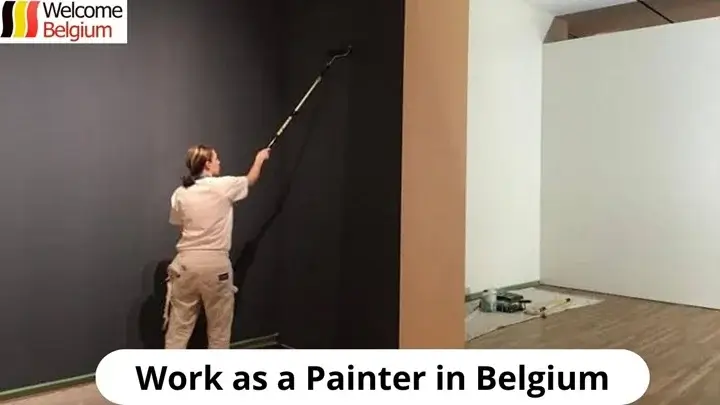Working as a painter in Belgium is a chance to earn a steady income of up to €4000 a month with great working conditions. The demand for skilled painters in construction and the automotive industry is growing, attracting migrants from the CIS countries. High salaries, housing, and social benefits make Belgium an ideal choice. Learn how to find a job, get a visa, and kickstart your career!
Work as a Painter in Belgium: What’s Happening in the Job Market
Belgium isn’t just about waffles, chocolate, and the charming streets of Bruges. It’s also a country where painters are in high demand! If you know how to handle a brush or a spray gun, there’s plenty of work, especially in construction and the automotive industry. The job market is buzzing: new buildings are popping up everywhere, and cars in auto shops are waiting for a perfect finish. Let’s dive into why being a painter in Belgium is awesome and what you need to fit in.
What’s Happening in the Job Market for Painters in Belgium:
- Construction is booming: residential homes, offices, and shopping centers all need painters to make walls shine.
- The automotive industry relies on painters: from factories to auto shops, where cars get a fresh, glossy look.
- Platforms like Flagma list over 200 painter vacancies, from beginners to seasoned pros.
- Migrants from the CIS feel at home here: the language barrier is low at the start, and employers often help with training.
- Salaries are attractive: on average €1800–2500 per month net, plus perks like health insurance and paid vacation.
Belgium is all about stability. The economy is steady, construction and automotive industries keep moving, meaning there’s always work. Migrants are valued for their hard work, especially if you’re willing to put in a Saturday for some extra cash. Plus, Belgium’s benefits package is no joke: insurance, help with paperwork, and even vacation time to hit the beach in Ostend. For those looking to earn and build a career, Belgium is a gem.
Tip:
Learn English or French to land better-paying jobs faster!
Requirements for Painters Working in Belgium
Working as a painter in Belgium is your chance to earn European-level wages while living in a country with great vibes. But what does it take to get hired? Let’s break down the experience, skills, and languages employers expect, plus the laws that govern it all.
Requirements for Working as a Painter in Belgium:
- Experience: 1–2 years is enough to get noticed, but eager beginners are often hired if they’re ready to learn (per the Labor Contracts Act of 3 July 1978, regulating the hiring of workers, including painters).
- Skills: You need to know how to use a spray gun, apply plaster, level walls, and do finishing work — these are often outlined in industry collective agreements (details at the Federal Employment Service).
- Languages: English at B1 level is your ticket in, while French or Dutch gives you an edge (language tips in job guides: Belgium.be).
- Certificates: Not mandatory, but a painter or plasterer diploma boosts your chances; for CIS migrants, it can confirm qualifications (info on qualification recognition: Vlaanderen).
- Physical fitness: The job demands stamina, with an age range typically of 18–50, aligning with labor safety standards in the Workers’ Wellbeing Act of 4 August 1996.
Belgian employers value those who work hard and are eager to learn. Even if your language skills aren’t perfect or you don’t have a stack of certificates, showing reliability is key. Full-time work is the norm, so expect a busy schedule but a paycheck that’s worth it. Laws like the Labor Contracts Act and Workers’ Wellbeing Act protect your rights, so you’re covered. Belgium is a place where your skills are appreciated, especially if you’re a master of your craft.
Besides painting, other construction trades like masonry are in demand in Belgium. Masons are needed for building and restoring structures, with steady job prospects for skilled workers.
Tip:
Create a portfolio of your work (photos of walls or cars you’ve painted) — it’ll really impress employers!
Salaries and Working Conditions for Painters in Belgium
Dreaming of painting walls or cars in Belgium and earning good money? Being a painter here isn’t just about brushes and paint—it’s about solid pay and great conditions. You can earn €12–20 per hour, plus get housing, transport, and even health insurance. Let’s break down the pay, work life, and how conditions differ for migrants and EU citizens.
| Region/Level | Minimum Salary | Maximum Salary |
| Flanders (Antwerp, Ghent) | €12/hour, €2000/month | €20/hour, €4000/month |
| Wallonia (Liège, Namur) | €12/hour, €2000/month | €18/hour, €3500/month |
| Brussels | €14/hour, €2500/month | €20/hour, €4000/month |
| Beginner (0–1 year experience) | €12/hour, €2000/month | €15/hour, €2800/month |
| Pro (2+ years experience) | €15/hour, €2800/month | €20/hour, €4000/month |
A painter’s salary in Belgium depends on a few factors: the region (Brussels and Flanders pay more than Wallonia), experience (pros with 2+ years earn up to €20/hour, beginners start at €12), specialization (auto painters often earn more than construction painters), language skills (English or French boost your rate), and overtime (extra hours add +50% to your pay). The type of contract and employer also matter—big companies pay more reliably than small firms.
Working Conditions for Painters in Belgium:
- Schedule: Usually 40–60 hours a week, with some flexibility but a fast pace (Working Time Laws, Act of 16 March 1971).
- Overtime: Extra hours pay generously, +50% to your rate, so you can earn more (regulated by the Labor Act).
- Housing: Costs €300–500/month, and employers often help find apartments or hostels (housing info for workers: Belgium.be).
- Transport: Worksite transport is often free, especially for distant projects (transport terms in collective agreements: Employment Belgium).
- Workwear: Usually provided, though some employers may ask you to bring your own (labor safety standards, Act of 4 August 1996).
- Health insurance: Mandatory for all workers, covering basic needs, with help for migrants to sign up (Health Act).
- Migrants vs. EU citizens: Conditions are similar, but CIS migrants need a work permit (type B, see Belgium.be), while EU citizens face no red tape. Migrants may get cheaper housing, but starting salaries can be slightly lower.
Belgium is about stability and comfort. Painters’ salaries here are higher than in many countries, and working conditions are clearly regulated by law, so you’re protected. Migrants face a bit more paperwork, but employers often help with visas and housing. If you’re ready to work hard, you can earn well and enjoy life in a country where beer and waffles are an art form.
Tip:
Always check if health insurance is included in your contract to avoid paying out of pocket!
How to Find a Job as a Painter in Belgium
Finding a job as a painter in Belgium is easier than you think if you know where to look and how to present yourself. From online platforms to direct company contacts, there are plenty of options, especially for hardworking folks from the CIS. Let’s dive into how to snag a job, craft a killer resume, and avoid scams.
Where and How to Find a Job as a Painter in Belgium:
- Job websites: [Flagma](https://be.flagma.eu/, support: info@flagma.eu), [Layboard](https://layboard.com/, tel.: +370 5 214 0169), [LinkedIn](https://www.linkedin.com/, sign up via email) — hundreds of painter jobs, from construction to auto shops.
- Recruitment agencies: Reach out to [Randstad Belgium](https://www.randstad.be/, tel.: +32 2 643 47 00, office: Boulevard du Roi Albert II 30, 1000 Brussels) or [Manpower Belgium](https://www.manpower.be/, tel.: +32 2 639 10 70, office: Avenue des Communautés 110, 1200 Woluwe-Saint-Lambert) — they assist migrants with paperwork and jobs.
- Social media: Check Facebook groups like Ukrainians in Belgium or Jobs in Belgium for job postings and contacts.
- Direct contacts: Find construction companies like [BESIX](https://www.besix.com/, tel.: +32 2 402 62 11, office: Avenue des Communautés 100, 1200 Brussels) and send your resume directly to their email.
- Resume: List your experience (even 1 year), skills (spray gun, plastering), and contacts; add a photo and a few words in English — it works (resume guide: Belgium.be).
- Interview: Be ready to talk about your experience and show photos of your work; learn a few phrases in English or French (interview tips: Employment Belgium).
- Verify employers: Look for reviews on forums or in groups, and check contracts via sites like Employment Belgium to avoid scams.
Belgium welcomes those ready to work with their hands. Websites, agencies, and social media are your best allies, and contacting companies directly can give you an edge. Don’t be shy, make a resume with heart, and double-check who you’re dealing with. There are plenty of jobs in Brussels, Antwerp, and beyond, especially for Ukrainians who’ve already earned a reputation as pros. So go for it — chase that job and some Belgian waffles!
The construction sector in Belgium covers many fields, and besides painters, electricians are in demand. They handle the installation, maintenance, and repair of electrical systems, essential for modern construction.
Tip:
Add a link to a portfolio of your work photos in your resume — it’ll show employers you’re not just talk but a true pro!
Documents for Working as a Painter in Belgium
First, you’ll need to gather a few key documents. For CIS citizens, it’s a bit more involved than for EU residents, but it’s totally doable if you approach it smartly. Let’s break down what papers you need, how long it takes, and how much it costs.
What You Need for Document Processing:
- Passport: Must be valid for at least one year — the foundation for any overseas job (details: Diplomatie Belgium).
- Visa: CIS citizens (Ukrainians, Belarusians) need an A1 visa for seasonal work up to 90 days or a D visa for long-term contracts; processing takes 2–4 weeks, costing €100–300 (info: VFS Global Belgium).
- Work permit: Non-EU citizens need a type B permit, usually handled by the employer via Employment Belgium; takes 2–3 weeks.
- EU citizens: Can work with an ID card or passport without extra permits (details: Belgium.be).
- Additional documents: Sometimes a criminal record check or medical certificate is required, especially for long-term contracts (check: Health Belgium).
Getting documents sorted for a painter job in Belgium is a crucial step, but it’s manageable. For CIS citizens, the key is finding an employer willing to help with the visa and work permit—then it’s smooth sailing. EU citizens have it easier, needing just a passport to get started. Costs and timelines are reasonable, and with support from agencies or companies, it’s even simpler.
Tip:
Before applying for a visa, ensure your passport has at least two blank pages to avoid rejection.
Popular Regions for Working as a Painter in Belgium
Wondering where to settle as a painter in Belgium? Though small, Belgium offers unique opportunities in each city: from high-end interior work in Brussels to industrial painting in Antwerp. Demand for painters is steady, but conditions, salaries, and job types vary. Let’s explore what each region offers to help you pick the perfect spot.
| Region | Pros | Cons |
| Brussels | Salaries €14–18/hour, plenty of interior finishing jobs (offices, apartments), steady demand due to capital status, great transport network | High housing costs (€400–600/month), competition among migrants, English or French needed |
| Antwerp | High salaries (€15–20/hour), lots of industrial painting work (ports, factories), cheaper housing than Brussels (€300–500/month) | Fewer jobs for beginners, preference for experienced painters, Dutch often required |
| Liège | Salaries €12–16/hour, demand for auto painters (workshops, factories), lower competition, affordable housing (€250–400/month) | Less job variety, more physical work, French is important |
Belgium offers painters plenty of opportunities, but your choice of region depends on your priorities. Brussels is great for those who love working on stylish interiors and don’t mind the city hustle. Antwerp suits pros ready for industrial tasks and higher pay. Liège is a gem for auto painters and those seeking a quieter, cheaper lifestyle. Demand is strong across these cities thanks to construction and automotive industries, and Belgian employers value hardworking CIS workers.
Tip:
For maximum earnings, aim for Antwerp, but make sure your experience stands out to impress employers!
Tips (FAQ)
How do I find a job as a painter in Belgium?
Look for jobs on platforms like Flagma, Layboard, or LinkedIn. Check Facebook groups like Ukrainians in Belgium or reach out directly to construction companies.
What documents do I need to work?
CIS citizens need a passport, an A1 visa for short-term work or a D visa for long-term, plus a type B work permit (often handled by the employer). EU citizens only need a passport or ID card.
How much do painters earn?
Salaries vary by region and experience: €12–20/hour or €2000–4000/month. Brussels and Antwerp pay more than Liège, with overtime adding +50% to your rate.
Do I need work experience?
1–2 years of experience helps, but beginners can get hired if they’re eager to learn. Skills like using a spray gun or plastering are a big plus.
What language level is required?
English at B1 is a good start, but French or Dutch opens up better jobs. You can manage without languages, but it’s tougher.
Can beginners without experience find work?
Yes, if you’re willing to learn and handle physical work. Some companies hire trainees and provide on-the-job training.
Do they provide housing and transport?
Often, yes: housing costs €300–500/month, and transport to work is usually free. Always confirm these details in your contract.
Are certificates required?
Not mandatory, but a painter or plasterer diploma improves your chances. Employers value verified experience.
How do I create a resume for Belgium?
Include your experience, skills (e.g., spray gun), contacts, and photos of your work. A short English blurb is a big win.
How do I avoid scams?
Check employer reviews on social media or forums and verify contracts through reliable sources. Work with trusted agencies or companies.





